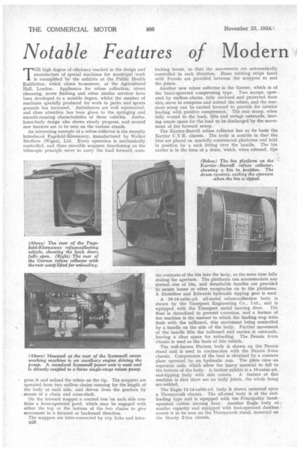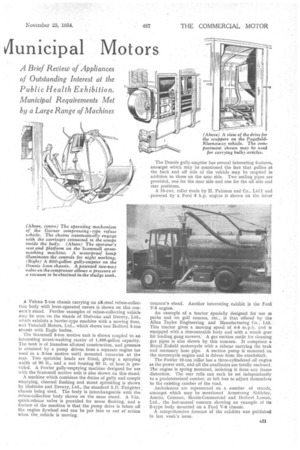Notable Features of Modern
Page 34

Page 35

If you've noticed an error in this article please click here to report it so we can fix it.
Aunicipal Motors
THE high degree of efficiency reached in the design and manufacture of special machines for municipal work is exemplified by the exhibits at the Public Health Exhibition, which closes to-morrow, at the Agricultural Hall, London. Appliances for refuse collection, street cleansing, sewer flushing and other similar services have been developed to a notable degree, whilst the number of machines specially produced for work in parks and sports grounds has increased. Ambulances are well represented, and close attention has been given to the springing and smooth-running characteristics of these vehicles. Ambulance-body design also shows steady progress, and several new features are to be seen on the various stands.
An interesting example of a refuse collector is the recently introduced Pagefteld-Kleenaway, manufactured by Walker Brothers (Wigan), Ltd. Every operation is mechanically controlled, and three movable scuppers functioning on the telescopic principle serve to carry the load forward, corn press it and unload the refuse on the tip. The scuppers are operated from two endless chains running for the length of the body at each side, and driven from the gearbox by _means of a chain and cross-shaft.
On the forward scupper a control box on each side contains a lever-operated pawl, which may be engaged with either the top or the bottom of the two chains to give movement in a forward or backward direction. • The scuppers are inter-connected by trip links and interB20 locking levers, so that the movements are automatically controlled in each direction. Brass rubbing strips faced with Ferodo are provided between the scuppers to seal the joints.
Another new refuse collector is the Garner, which is of the hand-operated compressing type. Two scoops, operated by endless chains, fully enclosed and protected from dirt, serve to compress and unload the refuse, and the rearmost scoop can be carried forward to provide for interior loading with positive compression. The rear scoop, when fully wound to the back, lifts and swings outwards, leav• ing ample space for the load to be discharged by the movement of the forward scoop.
The Karrier-Burrell refuse collector has as its basis the }Carrier C.Y.R. chassis. The body is notable in that the bins are placed on specially constructed platforms and held in position by a rack fitting over the handle. The bin carrier is in the form of a drum, which, when released, tips the contents of the bin into the body, at the same time fully sealing the aperture. The platforms can accommodate any normal size of bin, and detachable handles are provided to secure boxes or other receptacles on to the platforms. A Bromilow and Edwards hydraulic tipping gear is used.
A 10-13-cubic-yd. all-metal refuse-collection body is shown by the Transport Engineering Co., Ltd., and is equipped with the Transport metal moving floor. The floor is sheradized to prevent corrosion, and a feature of the machine is the manner in which the loading step folds flush with the tailboard, this movement being controlled by a handle on the side of the body. Further movement of the handle lifts the tailboard and carries it outwards, leaving a clear space for unloading. The Dennis 3-ton chassis is used as the basis of this vehicle.
The well-known Pactum body is shown on the Dennis stand and is used in conjunction with the Dennis 3-ton chassis. Compression of the load is obtained by a concave plate operated by an hydraulic ram. The plate runs on separator tails, which allow the heavy material to fall to the bottom of the body. A further exhibit is a 10-cubic-yd. end-tipping body with side covers. A feature of this machine is that there are no body joints, the whole being arc-welded.
The Eagle 12-14-cubic-yd. body is shown mounted upon a Thornycroft chassis. The all-steel body is of the endloading type and is equipped with the Principality handoperated rubber moving floor. Another Eagle body of smaller capacity and equipped with foot-operated dustless covers is to be seen on the Thornycroft stand, mounted on the Bandy 2-ton chassis.
A Vulcan 2-ton chassis carrying an all-steel refuse-collection body with lever-operated covers is shown on this concern's stand. Further examples of refuse-collecting vehicle may be seen on the stands of Shelvoke and Drewry, Ltd., which exhibits a barrier-type machine with a moving floor, and Vauxhall Motors, Ltd., which shows two Bedford 3-ton ehassis with Eagle bodies.
The Scammell 3-ton motive unit is shown coupled to an interesting street-washing carrier of 1,500-gallon capacity. The tank is of frameless all-steel construction, and pressure is obtained by a pump driven from a separate engine (as used in a 3-ton motive unit) mounted crosswise at the rear. Two sprinkler heads are fitted, giving a spraying width of 90 ft., and a reel housing 60 ft. of hose is provided. A Fowler gully-emptying machine designed for use with the Scammell motive unit is also shown on this stand.
A machine which combines the duties of gully and cesspit emptying, channel flushing and street sprinkling is shown by Shelvoke and Drewry, Ltd., the standard S.D. Freighter. chassis being used. The body is interchangeable with the refuse-collection body shown on the same stand. A 7-in. quick-release valve is provided for sewer flushing, and a feature of the machine is that the pump drive is taken off the engine flywheel and can be put into or out of action when the vehicle is moving.
concern's stand. Another interesting exhibit is the Ford V-8 engine.
An example of a tractor specially designed for use in parks and on golf courses, etc., is that offered by the Allan Taylor Engineering and Manufacturing Co., Ltd. This tractor gives a mowing speed of 4-8 m.p.h. and is equipped with a demountable body and with a winch gear for loading gang mowers. A gas suction outfit for cleaning gas pipes is also shown by this concern. It comprises a Royal Enfield motorcycle with a sidecar carrying the tank and necessary hose pipe. A suction pump is mounted on the motorcycle engine and is driven from the crankshaft.
The Fowler 10-ton roller has a three-cylindered oil engine as the power unit, and all the auxiliaries are totally enclosed. The engine is spring mounted, isolating it from any frame distortion. The rear rolls can each be set independently to a predetermined camber; or left free to adjust themselves to the existing camber of the road. Ambulances are represented on a number of stands, amongst which may be mentioned Armstrong Sidcleley, Austin, Com:tier, Morris-Commercial and• Herbert Lomas, Ltd., the last-named' concern showing an example of its S-type body mounted on a Ford V-8 chassis.
A comprehensive forecast of the exhibits was published in last week's issue.




























































































